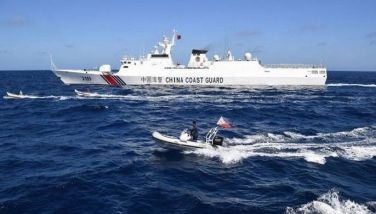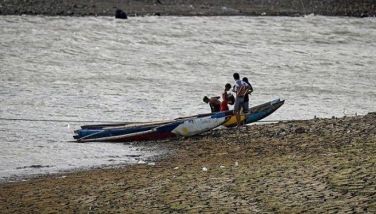Analysis: A path for dispute resolution in the South China Sea
Located in the heart of Southeast Asia, the South China Sea is a semi-enclosed sea surrounded by China and several small and militarily weaker Southeast Asian powers such as the Philippines, Vietnam, Malaysia and Brunei. Since the mid-1970s, these states have been involved in a chronic competition as each one seeks to extend its sovereignty and jurisdictional claims over more than a hundred islets, reefs, and rocks and their surrounding waters.
Despite this competition, the South China Sea dispute hibernated in the late 1990s and the early 2000s after China and the Association of Southeast Asian Nations (ASEAN) signed the 2002 Declaration on the Conduct of Parties in the South China Sea.
China’s seven-year strategic shift
The maritime row flared up in 2009 when China assumed an assertive posture, attempting to consolidate its jurisdictional claims in the South China Sea by expanding its military reach and pursuing coercive diplomacy against the other claimant states. China increased its naval patrols (using submarines, survey ships, and surface combatants) in Japan’s Exclusive Economic Zone (EEZ) and territorial waters, and intimidated foreign oil companies that tried to operate in the South China Sea.
Since 2009, China has shifted its strategy from one that delays the resolution of the dispute to one that emphasizes its sovereignty over the contested waters, to deter other claimant states like the Philippines and Vietnam from cementing their claims and to negotiate with these small powers from a position of strength. Recently, the dispute has become more problematic as the claimant states have been inclined to deploy naval assets in controlling the disputed offshore territories, and to demonstrate their resolve to keep them.
Since 2009, China has shifted its strategy from one that delays the resolution of the dispute to one that emphasizes its sovereignty over the contested waters.
Major powers enter the fray
The South China Sea dispute is one of four potential flashpoints in East Asia, along with the Korean Peninsula, the East China Sea and the Taiwan Straits. In the past years, China’s efforts to control 80 percent of the South China Sea have alarmed smaller claimant states, such as the Philippines and Vietnam; in response, these two countries invited two major naval powers into the fray, the United States and Japan.
Statements from Washington have previously indicated that its leadership is troubled by China’s bullying behavior towards the smaller claimant states, as well as any behavior that could impact America’s ability to sail in or fly over the South China Sea in line with law.
Japan, on the other hand, is pressured by China over the Senkaku/Diaoyu islands and, consequently, has become interested in the South China Sea disputes as well. In Japan’s thinking, the way in which the South China Sea disputes are resolved (or not) will have a bearing on Japan’s interests in the East China Sea.
The presence of these three major naval powers—US, Japan, and China—in the South China Sea has generated a stable but fragile security situation. This security situation is marked by an old-fashioned strategic balancing of a major regional power by two small powers that depend on extra-regional maritime powers to maintain the status quo for the unforeseeable future.
The presence of these three major naval powers—US, Japan, and China—in the South China Sea has generated a stable but fragile security situation.
The balance of power in the South China Sea dispute has prevented an armed conflict among the claimant states. However, this situation has two major flaws: first, it features a very fluid situation in which any armed confrontation may escalate and drag the other maritime powers into a major systemic war. Second, while the balance of power system has stabilized the situation, it has simply failed to resolve the dispute and created a tense strategic impasse.
Resolving the strategic impasse
It is this second feature, the strategic impasse that could transform the balance of power system into a schema of stable peace. To achieve it, the probability of war, especially among the major powers, must be minimized. This requires each country to lower the possibility of resorting to violence to pursue their strategic and political objectives. When applied to the South China Sea disputes, this process could involve the following stages:
The first stage necessitates one party in the dispute to initiate a unilateral accommodation by sending a message of benign intent to the other parties. As the biggest and powerful state in East Asia, China needs to modify, if not abandon, its strategy of delaying the resolution of the dispute. By delaying the resolution, it is able to consolidate its expansive claim and prevent other claimant states from consolidating their own claims.
As the biggest and powerful state in East Asia, China needs to modify, if not abandon, its strategy of delaying the resolution of the dispute.
The second stage involves the implementation of individual acts of unilateral accommodation, in order to pave the way for reciprocal restraint by the other disputing states. China and the ASEAN states should finalize and sign a binding Code of Conduct on the South China Sea and even an Incident at Sea Agreement (INCSEA) that will define how their naval and coast guard units should operate in the disputed waters.
The third stage involves the intensification of direct contacts of the claimant states’ civil societies that will lead to joint economic ventures in the disputed waters. These moves could include joint development of hydrocarbon and fisheries resources by the claimant states’ private companies and their foreign partners.
The fourth and final stage is the establishment of a stable peace in the South China Sea is the generation of a new narrative about how the disputing states’ relations are transformed from conflict to reconciliation.
China’s move
With its size and location in East Asia, robust economy and military prowess, China is the most able among the claimant states to initiates a policy of unilateral accommodation in the South China Sea. Such a policy would require China to be conciliatory and flexible to prevent the small littoral states from adopting a balancing policy that involves bringing both the U.S. and Japan into the strategic equilibrium.
Unfortunately, instead of being conciliatory to the small Southeast Asian powers, China is still embarking on a policy of maritime expansion. The current Chinese leadership feels confident that with their country’s new political and economic clout and a powerful People’s Liberation Army, China can advance its core interests in the maritime domain.
Instead of being conciliatory to the small Southeast Asian powers, China is still embarking on a policy of maritime expansion.
However, China’s assertive power-based approach in imposing its expansive claim in the South China Sea has rekindled both Japanese and American strategic attention and interests in the region. These developments inevitably increase the uncertainty in the disputed waters and direct us into a scenario where “Asia’s uncertain future will be Europe’s bellicose and violent past.”
This worst-case scenario will be prevented if stable peace will break out in East Asia. For this to happen, China must change its realpolitik approach to the dispute. The long-term resolution of the imbroglio will only begin by China’s unilateral accommodation of the views and interests of the small claimant states. Taking this first step entails enormous restraint as well as diplomatic flexibility and, more importantly, humility on the part of the emergent power.
***
Renato Cruz De Castro, Ph.D. is a trustee and program convenor for foreign policy and regional security at the Stratbase Albert Del Rosario Institute (ADRi) and a professor at the De La Salle University.
- Latest
- Trending

























